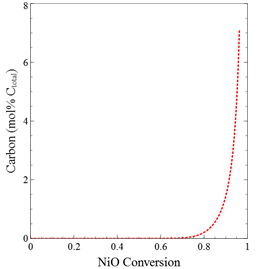

Chemical-looping combustion is a method for the oxidation of hydrocarbons with in-situ CO2 capture. The basic concept of the process involves two interconnected reactors, a Reducer and an Oxidizer, with an oxygen carrier (OC) ¨C a metal/metal oxide circulating between the two. The main principle in chemical-looping is the oxidation of hydrocarbons with a metal oxide in a N2-free environment. In this study, a transient non-ideal reactor model was developed for two types of Reducers: fixed and fluidized bed [1,2]. The models capture the most important dynamic and spatial phenomena in CLC reduction. The mass balance of 9 species and the energy balance are simulated in both models by the same kinetics mechanisms and reaction constants.
In this work, Ni-based CLC tests in fixed-bed and spouted-bed CLC reactors operated in the University of Connecticut are discussed and the simulation of different fixed and fluidized bed unit data reported in the literature and data of this study are presented. Comparison between experimental and predicted results reveals that the process models and kinetics network proposed are successful in predicting chemical-looping combustion in fixed- and fluidized bed reactors. Through model-assisted comparison between the two types of reactors, some substantial issues in the CLC system performance are discussed. For instance, the comparison of carbon formation (Figure 1) between the two types of reactors (reactor configurations of Iliuta et al. [3]) shows that carbon deposition is not significant in the fluidized bed reactor; whereas, it is of concern at higher conversions in a fixed-bed reactor. Based on the developed reactor models, fixed-bed scale-up calculations are carried out. Spatial and transient pressure and temperature variations are shown and analyzed. Other issues, like challenges in operating CLC at minimum oxygen carrier loading (therefore, smaller Reducer size), OC loading required for high CH4 conversion and OC conversion, time of starting of significant carbon formation at a given OC loading, and CO2 selectivity of fluidized-bed and scale-up fixed-bed units will be discussed.
Figure 1: Carbon formation of NiO based OC chemical-looping reduction process in (a) fixed-bed and (b) fluidized bed reactors[3].
Acknowledgement: This material is based upon work supported by the National Science Foundation under Grant No. 1054718.
[1] D. Kunii, O. Levenspiel, Bubbling bed model: model for the flow of gas through a fluidized bed, I & EC Fundamentals. 7 (1968) 446¨C452.
[2] D. Kunii, O. Levenspiel, Bubbling bed model for kinetic processes in fluidized beds: Gas-Solid Mass and Heat Transfer and Catalytic Reactions, I & EC Process Design and Development. 7 (1968) 481¨C492.
[3] I. Iliuta, R. Tahoces, G.S. Patience, S. Rifflart, F. Luck, Chemical-looping combustion process : kinetics and mathematical modeling, AIChE J. 56 (2010) 1063¨C1079.


